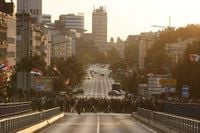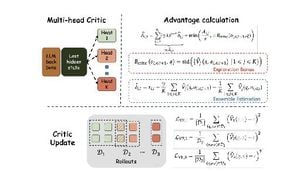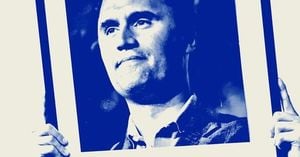On Saturday, September 13, 2025, Serbia found itself at a political crossroads as anti-government protesters and supporters of President Aleksandar Vucic staged parallel rallies across the country. The scenes, which played out in cities and towns from Belgrade to Novi Sad, reflected the deepening political crisis gripping the Balkan nation after more than ten months of persistent protests against Vucic’s populist government. According to the Associated Press and multiple local reports, police maintained a visible presence, separating the two opposing camps and preventing any major incidents—though the underlying tension was impossible to ignore.
The day’s events were the latest chapter in a saga that began in November 2024, when tragedy struck the northern city of Novi Sad. A concrete canopy collapsed at a newly renovated train station, killing sixteen people and sparking national outrage. Many Serbians blamed the disaster on corruption-fueled negligence, and the calls for justice quickly evolved into a broader movement demanding political accountability and reform. What started as a quest for answers over a preventable tragedy soon grew into a nationwide protest movement that has drawn hundreds of thousands into the streets over the past year, as reported by AP and local news outlets.
In an effort to counter the persistent and largely student-led protests, Vucic’s Serbian Progressive Party recently began organizing its own demonstrations. These pro-government rallies, often timed to coincide with opposition gatherings, have become a fixture of Serbia’s fractured political landscape. Saturday’s rallies were no exception, with both camps assembling in force, their numbers swelling as the day wore on. Police and gendarmerie officers took up strategic positions, blocking bridges and streets—especially in Novi Sad—to keep the rival groups apart. In Belgrade, the capital, brief scuffles broke out when riot police pushed away anti-government protesters as President Vucic made a public appearance among his supporters, a show of confidence that did little to bridge the widening divide.
Despite the heavy police presence and the palpable tension, the rallies ended without any major incidents. Still, the atmosphere was charged. According to AP, Vucic addressed his supporters, emphasizing the desire for peace and normalcy: “People want to live normally, they don’t want to be harassed and want to be free.” His words, while intended as reassurance, were met with skepticism by many on the other side of the barricades.
For months, student leaders and opposition groups have called for early parliamentary elections—a demand that Vucic has flatly refused. Instead, the president has doubled down, stepping up a crackdown on the protest movement. Over one hundred university professors have been dismissed in what critics describe as a purge of dissenting voices from academic institutions. Meanwhile, police have faced mounting accusations of brutality against peaceful demonstrators, with human rights organizations and opposition figures sounding the alarm over what they see as a pattern of state overreach and intimidation.
Vucic, for his part, has not shied away from inflammatory rhetoric. In recent statements, he accused the student-led protesters of being “terrorists” acting under orders from the West, though he has offered no evidence to support these claims. The president’s characterization of his opponents has only deepened the sense of polarization in Serbia, with each side accusing the other of undermining the nation’s future. The Associated Press and other outlets have noted that such accusations, lacking substantiation, have done little to calm the waters.
The roots of the current crisis run deep. The initial protests, sparked by the Novi Sad tragedy, quickly became a lightning rod for broader grievances—corruption, lack of transparency, and the perceived erosion of democratic norms. What began as a spontaneous outpouring of grief and anger has since evolved into a sustained campaign for change, with students and young people at the forefront. Their persistence has been remarkable, drawing hundreds of thousands into the streets over the past ten months and forcing the government to respond, albeit often with force rather than dialogue.
In response to the mounting pressure, Vucic’s Serbian Progressive Party has sought to reclaim the narrative, organizing counter-demonstrations and rallying its base. These efforts have been described by some observers as an attempt to project strength and maintain a semblance of control. Yet, the parallel rallies on Saturday—carefully choreographed and heavily policed—served as a stark reminder of just how divided Serbian society has become.
Throughout the day, images of Serbian gendarmerie officers blocking bridges and streets in Novi Sad circulated widely, underscoring the lengths to which authorities have gone to prevent clashes. In Belgrade, the brief scuffles between riot police and anti-government protesters as Vucic joined his supporters were a microcosm of the broader struggle for Serbia’s political soul. While no major injuries were reported, the confrontations left an indelible mark on the day’s proceedings.
The government’s crackdown has not been limited to the streets. The dismissal of more than one hundred university professors has sent shockwaves through Serbia’s academic community, raising concerns about academic freedom and the right to dissent. Meanwhile, allegations of police brutality continue to circulate, with activists and opposition figures documenting what they describe as excessive use of force against peaceful demonstrators. These developments have drawn criticism from both domestic and international observers, who warn that the government’s heavy-handed approach risks further inflaming tensions.
Despite the government’s efforts to paint the protesters as foreign agents or extremists, the movement’s core demands remain rooted in a desire for justice, accountability, and democratic reform. The tragedy in Novi Sad, which claimed sixteen lives, remains a potent symbol of what many see as the consequences of unchecked power and corruption. As the protests have grown, so too has the sense of urgency among those calling for change.
On the other side, Vucic and his supporters argue that stability and order are paramount. They accuse the opposition of seeking to destabilize the country and undermine its sovereignty, framing the protests as part of a broader campaign orchestrated from abroad. This narrative, though unsubstantiated, resonates with segments of the population wary of outside interference and longing for a return to normalcy.
As Serbia enters its eleventh month of political turmoil, the path forward remains uncertain. Saturday’s parallel rallies, though largely peaceful, offered little hope of reconciliation. With both sides digging in their heels and the government showing no sign of yielding to demands for early elections, the prospect of a negotiated solution appears remote. For now, the streets of Serbia remain a battleground—not just for competing visions of the country’s future, but for the very soul of its democracy.






